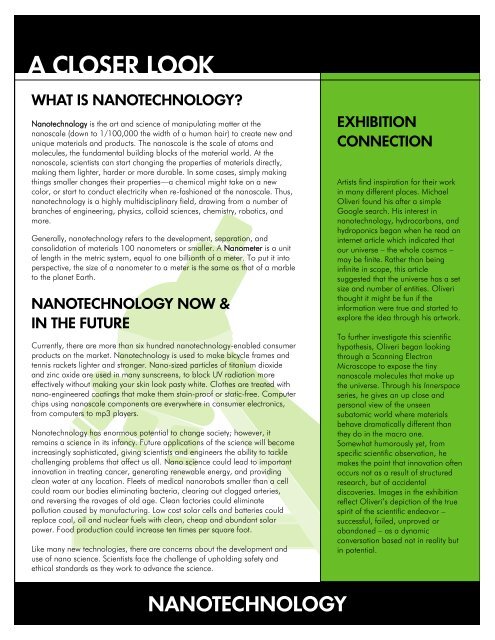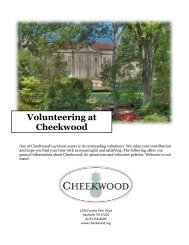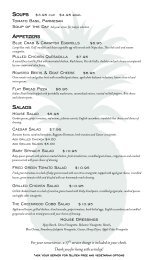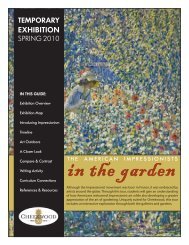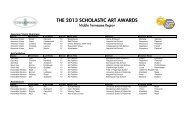Michael Oliver - Cheekwood Botanical Garden and Museum of Art
Michael Oliver - Cheekwood Botanical Garden and Museum of Art
Michael Oliver - Cheekwood Botanical Garden and Museum of Art
Create successful ePaper yourself
Turn your PDF publications into a flip-book with our unique Google optimized e-Paper software.
A CLOSER LOOK<br />
WHAT IS NANOTECHNOLOGY?<br />
Nanotechnology is the art <strong>and</strong> science <strong>of</strong> manipulating matter at the<br />
nanoscale (down to 1/100,000 the width <strong>of</strong> a human hair) to create new <strong>and</strong><br />
unique materials <strong>and</strong> products. The nanoscale is the scale <strong>of</strong> atoms <strong>and</strong><br />
molecules, the fundamental building blocks <strong>of</strong> the material world. At the<br />
nanoscale, scientists can start changing the properties <strong>of</strong> materials directly,<br />
making them lighter, harder or more durable. In some cases, simply making<br />
things smaller changes their properties—a chemical might take on a new<br />
color, or start to conduct electricity when re-fashioned at the nanoscale. Thus,<br />
nanotechnology is a highly multidisciplinary field, drawing from a number <strong>of</strong><br />
branches <strong>of</strong> engineering, physics, colloid sciences, chemistry, robotics, <strong>and</strong><br />
more.<br />
Generally, nanotechnology refers to the development, separation, <strong>and</strong><br />
consolidation <strong>of</strong> materials 100 nanometers or smaller. A Nanometer is a unit<br />
<strong>of</strong> length in the metric system, equal to one billionth <strong>of</strong> a meter. To put it into<br />
perspective, the size <strong>of</strong> a nanometer to a meter is the same as that <strong>of</strong> a marble<br />
to the planet Earth.<br />
NANOTECHNOLOGY NOW &<br />
IN THE FUTURE<br />
Currently, there are more than six hundred nanotechnology-enabled consumer<br />
products on the market. Nanotechnology is used to make bicycle frames <strong>and</strong><br />
tennis rackets lighter <strong>and</strong> stronger. Nano-sized particles <strong>of</strong> titanium dioxide<br />
<strong>and</strong> zinc oxide are used in many sunscreens, to block UV radiation more<br />
effectively without making your skin look pasty white. Clothes are treated with<br />
nano-engineered coatings that make them stain-pro<strong>of</strong> or static-free. Computer<br />
chips using nanoscale components are everywhere in consumer electronics,<br />
from computers to mp3 players.<br />
Nanotechnology has enormous potential to change society; however, it<br />
remains a science in its infancy. Future applications <strong>of</strong> the science will become<br />
increasingly sophisticated, giving scientists <strong>and</strong> engineers the ability to tackle<br />
challenging problems that affect us all. Nano science could lead to important<br />
innovation in treating cancer, generating renewable energy, <strong>and</strong> providing<br />
clean water at any location. Fleets <strong>of</strong> medical nanorobots smaller than a cell<br />
could roam our bodies eliminating bacteria, clearing out clogged arteries,<br />
<strong>and</strong> reversing the ravages <strong>of</strong> old age. Clean factories could eliminate<br />
pollution caused by manufacturing. Low cost solar cells <strong>and</strong> batteries could<br />
replace coal, oil <strong>and</strong> nuclear fuels with clean, cheap <strong>and</strong> abundant solar<br />
power. Food production could increase ten times per square foot.<br />
Like many new technologies, there are concerns about the development <strong>and</strong><br />
use <strong>of</strong> nano science. Scientists face the challenge <strong>of</strong> upholding safety <strong>and</strong><br />
ethical st<strong>and</strong>ards as they work to advance the science.<br />
EXHIBITION<br />
CONNECTION<br />
<strong>Art</strong>ists find inspiration for their work<br />
in many different places. <strong>Michael</strong><br />
<strong>Oliver</strong>i found his after a simple<br />
Google search. His interest in<br />
nanotechnology, hydrocarbons, <strong>and</strong><br />
hydroponics began when he read an<br />
internet article which indicated that<br />
our universe – the whole cosmos –<br />
may be finite. Rather than being<br />
infinite in scope, this article<br />
suggested that the universe has a set<br />
size <strong>and</strong> number <strong>of</strong> entities. <strong>Oliver</strong>i<br />
thought it might be fun if the<br />
information were true <strong>and</strong> started to<br />
explore the idea through his artwork.<br />
To further investigate this scientific<br />
hypothesis, <strong>Oliver</strong>i began looking<br />
through a Scanning Electron<br />
Microscope to expose the tiny<br />
nanoscale molecules that make up<br />
the universe. Through his Innerspace<br />
series, he gives an up close <strong>and</strong><br />
personal view <strong>of</strong> the unseen<br />
subatomic world where materials<br />
behave dramatically different than<br />
they do in the macro one.<br />
Somewhat humorously yet, from<br />
specific scientific observation, he<br />
makes the point that innovation <strong>of</strong>ten<br />
occurs not as a result <strong>of</strong> structured<br />
research, but <strong>of</strong> accidental<br />
discoveries. Images in the exhibition<br />
reflect <strong>Oliver</strong>i‘s depiction <strong>of</strong> the true<br />
spirit <strong>of</strong> the scientific endeavor –<br />
successful, failed, unproved or<br />
ab<strong>and</strong>oned – as a dynamic<br />
conversation based not in reality but<br />
in potential.<br />
NANOTECHNOLOGY


